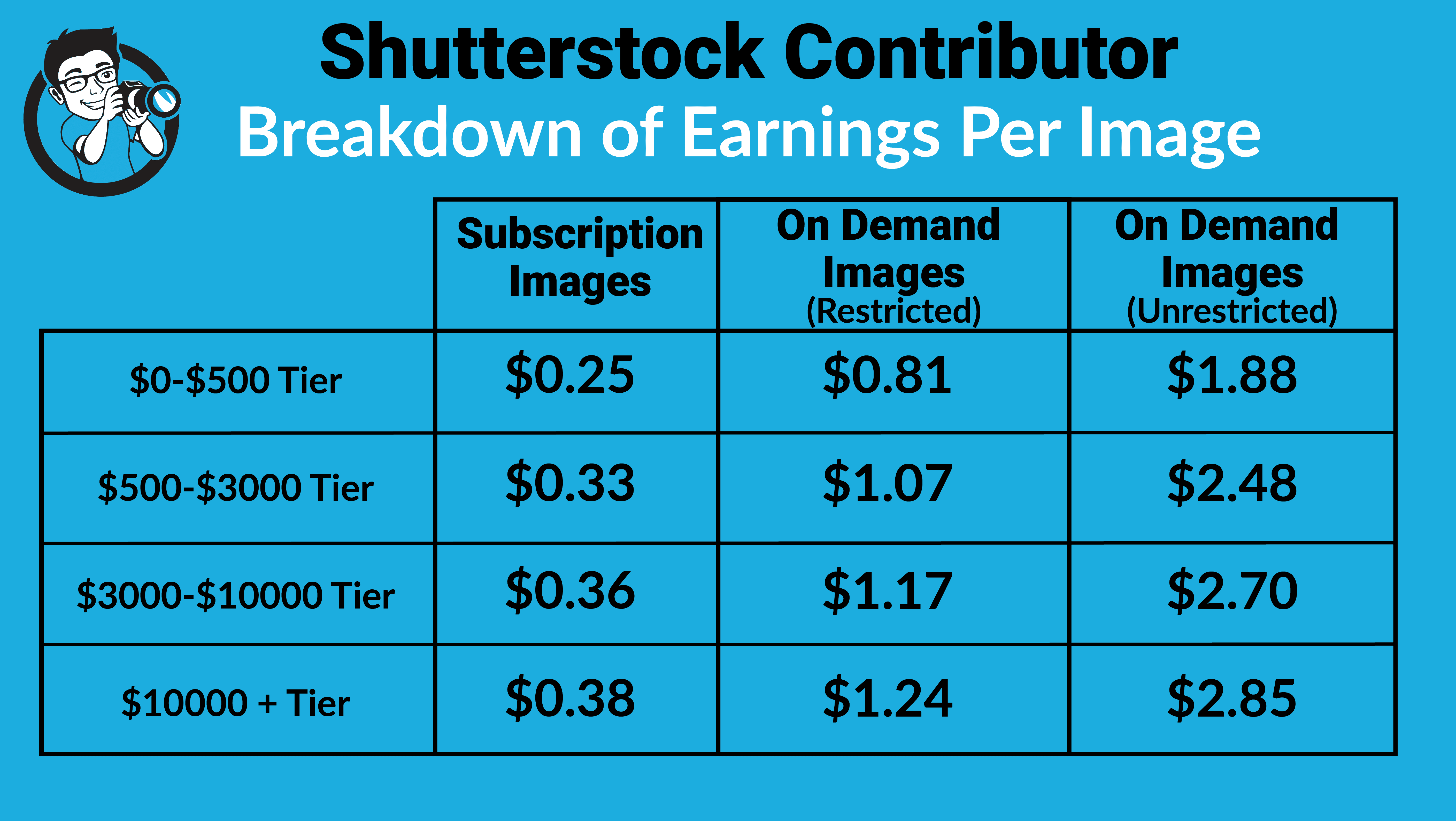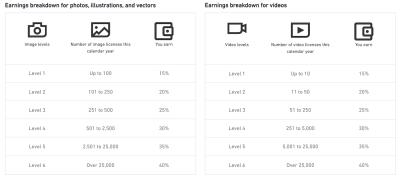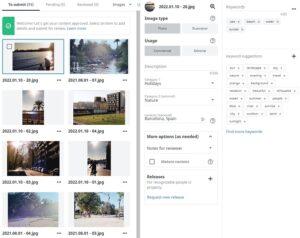If you’ve ever dabbled in photography or digital art, you’ve probably heard of Shutterstock — one of the biggest stock photo platforms out there. It’s a marketplace where creators like you can upload images, videos, and illustrations, and earn money whenever someone licenses your work. The coolest part? Shutterstock’s Contributor Program makes it super accessible for everyone, whether you’re a seasoned professional or just starting out. You don’t need a fancy studio or a huge portfolio to get started. Instead, all you need is some good-quality content, a bit of patience, and a drive to share your creativity with the world. Let’s dive into what you can expect as a part-time contributor and how much you might be able to earn!
Understanding Part-Time Contribution and Earning Potential

Thinking about contributing part-time on Shutterstock? That’s a smart move if you want to turn your hobby into some extra cash without quitting your day job. As a part-time contributor, you upload your images or videos whenever you have free time, and you earn passive income each time someone licenses your work. It’s flexible — you decide how much and how often to upload, making it perfect for those juggling other commitments.
So, what kind of earnings can you expect? Well, it varies quite a bit depending on factors like the quality of your content, how niche your images are, and how active you are. Some contributors make just a few dollars a month, while others earn hundreds or even thousands on the side. The key is understanding the earning structure:
- Royalty Rates: Shutterstock offers a tiered royalty system that rewards contributors based on their lifetime earnings and exclusivity. New contributors typically start earning around 15-30% of the license fee, but this can increase over time.
- Sales Volume: The more high-quality images you upload, the higher your chances of making sales. Consistency and niche targeting can really boost your earning potential.
- Content Quality and Relevance: Unique, well-composed, and relevant images tend to sell better. Investing time in capturing or creating standout content can pay off.
In terms of actual numbers, many part-time contributors report earning anywhere from a few dollars per month to several hundred dollars, especially as they build their portfolio and reputation. Remember, it’s not usually a quick-rich scheme — but with patience and persistence, Shutterstock can become a nice source of supplemental income. Plus, as your portfolio grows, so does your potential for earnings. It’s a flexible way to monetize your creative skills without the pressure of full-time commitments.
Factors That Influence Your Shutterstock Earnings
When it comes to earning money as a part-time contributor on Shutterstock, a lot of things come into play. It’s not just about uploading a handful of images and waiting for the dollars to roll in. Your income depends on several key factors that can either boost your earnings or hold them back. Let’s break down some of the most important ones.
Quality of Your Content: Shutterstock highly values high-quality, professional-looking images and videos. The clearer, well-composed, and visually appealing your submissions are, the better your chances of getting accepted and earning higher royalties. Low-quality or poorly lit images might get rejected or generate less income.
Quantity of Submissions: The more content you upload, the greater your potential to earn. However, it’s not just about quantity—your uploads should also be relevant and in demand. Consistent uploads give you more chances to appear in searches and attract buyers.
Keywording and Metadata: Properly tagging your content with accurate and descriptive keywords is crucial. Good metadata makes your images more discoverable. Think about what buyers might search for and include relevant terms. Well-optimized keywords can significantly increase your views and sales.
Content Niche: Some niches are more popular and profitable than others. For example, business, technology, health, and lifestyle images tend to sell well. If you focus on trending topics or evergreen themes, you’ll have a better shot at earning more.
Exclusive vs. Non-Exclusive Contributions: Shutterstock offers options to be exclusive or non-exclusive. Exclusive contributors often earn higher royalties or bonuses but commit to only selling their content through Shutterstock. Non-exclusive contributors can sell their content elsewhere, too, but typically earn slightly less per download.
Market Demand and Trends: The demand for certain types of content fluctuates over time. Staying updated on current trends and creating content that matches what buyers are searching for can boost your earnings.
In a nutshell, your earnings are a mix of quality, quantity, strategy, and market trends. The more you understand these factors and tailor your contributions accordingly, the better your chances of earning a steady income—even part-time!
Average Income for Part-Time Shutterstock Contributors
So, what can you realistically expect to earn as a part-time contributor on Shutterstock? It’s a common question, especially if you’re considering turning your hobby into a side gig. The truth is, income varies widely depending on how much time and effort you invest, as well as your content quality and niche.
Based on data from experienced contributors and industry reports up until 2023, here’s a rough idea of what part-time contributors might earn:
| Monthly Income Range | Number of Contributors | Notes |
|---|---|---|
| $50 – $200 | Majority | Many part-timers earn in this range, especially when just starting out or uploading infrequently. |
| $200 – $500 | Moderate group | Contributors who upload regularly, optimize keywords, and focus on popular niches. |
| $500 and above | Less common for part-timers | Typically achieved by highly active contributors with a large portfolio and niche expertise. |
It’s important to remember that these figures are averages and can fluctuate. Some contributors start earning only a few dollars a month but see their income grow over time as they build a larger portfolio and refine their strategy.
Many part-time contributors report earning around $100 to $300 per month after a year or so of consistent uploading and optimization. While this might not replace a full-time job, it can certainly supplement your income, cover some expenses, or fund your hobby materials.
Ultimately, your earnings depend on your dedication, content quality, and understanding of the market. With persistence and smart strategies, even part-timers can turn Shutterstock contributions into a meaningful side income. Keep creating, keep learning, and over time, you might be surprised at how much you can earn!
Tips to Maximize Your Earnings on Shutterstock
So, you’re diving into the world of Shutterstock as a part-time contributor and wondering how to make the most of it. The good news is, with a few smart strategies, you can significantly boost your earnings and turn your passion into a steady side income.
First off, quality over quantity always wins. Shutterstock values high-quality images, so invest time in capturing sharp, well-composed, and relevant photos. Use good lighting, pay attention to composition, and ensure your files are properly edited. Remember, images that stand out tend to get more downloads.
Next, diversify your portfolio. Don’t put all your eggs in one basket. Upload different types of content—photos, vectors, videos, and illustrations. Different buyers look for different media, so having a broad portfolio increases your chances of making sales.
Optimize your keywords and descriptions. Think like a buyer: what words would they use to find your content? Use clear, descriptive, and relevant keywords. The more accurately your content is tagged, the higher the chances it’ll show up in search results.
Stay current with trending topics and seasonal content. For example, during holidays or special events, content related to those themes tends to see a spike in demand. Keep an eye on popular categories and create content that aligns with what’s trending.
Engage with the community. Follow successful contributors, participate in forums, and learn from others’ experiences. Shutterstock also offers contests and challenges—participating can boost your visibility and motivation.
Lastly, be consistent. Upload regularly to keep your portfolio fresh and increase your chances of being discovered. Over time, as your portfolio grows and improves, so will your earning potential. Remember, patience and persistence are key!
Challenges and Considerations for Part-Time Contributors
While becoming a part-time contributor on Shutterstock can be rewarding, it’s important to be aware of some challenges and considerations that come with it. Being prepared can help you navigate these hurdles more effectively.
One common challenge is standing out in a crowded marketplace. Shutterstock hosts millions of images, so getting your work noticed can be tough, especially if you’re only uploading part-time. Consistently producing high-quality, unique content can help set you apart, but it takes time and effort.
Another consideration is the income variability. As a part-time contributor, your earnings will fluctuate based on demand, seasonality, and the popularity of your content. Some months might be great, while others may see fewer sales. It’s wise to view this as supplemental income rather than a steady paycheck.
Additionally, understanding licensing and copyright rules is crucial. Make sure you have the rights to all elements in your images, especially if they include recognizable people, trademarks, or copyrighted property. Failing to do so can lead to content rejection or even legal issues.
Time management can also be a challenge. Balancing your main job or other commitments with content creation requires discipline. Setting aside dedicated time for photography, editing, and uploading helps maintain consistency without burnout.
Lastly, stay updated with Shutterstock’s policies and platform changes. The digital marketplace evolves, and new rules or algorithms can impact your visibility and earnings. Regularly reviewing contributor guidelines and participating in forums can keep you informed.
In summary, while there are hurdles, approaching your Shutterstock journey with patience, professionalism, and strategic planning can make it a fulfilling side venture. Keep learning, stay motivated, and enjoy the creative process!
Conclusion and Next Steps for Aspiring Shutterstock Contributors
Embarking on a journey as a part-time contributor on Shutterstock offers a promising opportunity to generate additional income while sharing your creative work with a global audience. While earnings vary based on factors such as the quality of your submissions, the number of accepted files, and your chosen licensing options, many contributors find that consistent effort can lead to a steady revenue stream. Remember, success on Shutterstock requires patience, persistence, and continuous improvement of your portfolio.
To maximize your earning potential, consider the following next steps:
- Research Market Trends: Stay updated on popular topics and styles that sell well.
- Enhance Your Skills: Invest in improving your photography, design, or illustration skills.
- Optimize Your Submissions: Use relevant keywords, clear titles, and accurate descriptions to increase discoverability.
- Build a Consistent Portfolio: Regularly upload high-quality content to maintain visibility and growth.
- Engage with the Community: Join forums and read resources to learn best practices and gain inspiration.
By taking these steps, you can position yourself for success as a part-time Shutterstock contributor. Stay dedicated, be adaptable to market demands, and continually refine your craft. With time and effort, you can turn your creative passions into a rewarding side income.


